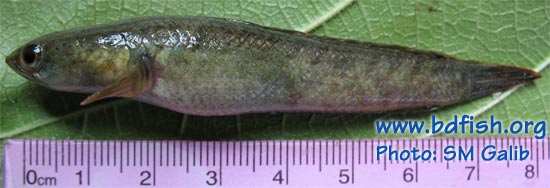
Systematic position
Phylum: Chordata
Class: Actinopterygii (Ray-finned fishes)
Order: Perciformes (Perches)
Suborder: Channoidei (Ophiocephaliformes)
Family: Channidae (Snakeheads)
Genus: Channa
Species: C. orientalis
Synonyms
Channa gachua (non-Hamilton, 1822; misspelled name)
Ophicephalus apus Canestrini, 1861
Ophiocephalus apus Canestrini, 1861
Ophiocephalus aurantiacus Hamilton, 1822
Common/local names
English: Asiatic snakehead and Walking snakehead
Bangladesh: Gaira (ঘাইরা), Gachua (গাচুয়া), Raga (রাগা), Cheng (চ্যাং) and Telo taki (তোলো টাকি)
India: Chengal (Assam); Cheng (West Bengal); Dheridhok, Chainga (Bihar); Dorrah (Punjab); Chenga (Orissa); Malamatta-gudisa, Erramattta, Tatimatta-gudisa (Andhra Pradesh); Parakoravai, Maniam-koravai (Tamil Nadu); Koravu, Vattudi (Kerala); Mohkorava, Mottu (Karnataka) (Talwar and Jhingran, 1991).
Distributions: Bangladesh, India, Pakistan, Afghanistan, Nepal, Sri Lanka, Iran, Myanmar and East Indies (Talwar and Jhingran, 1991); Vietnam, Thailand and Cambodia (IUCN Bangladesh, 2000).
Conservation status: Vulnerable in Bangladesh due to loss of habitats (IUCN Bangladesh, 2000).
Morphology: Body elongate and fairly rounded in cross section. Anterior nasal opening produced into a tubular process. Eyes moderate, mouth moderately cleft and large. Pectoral fin extend to anal fin and pelvic fin (often absent) less than 50% of pectoral fin length. Head scales large and situated behind the orbit. 40-45 (Bhuiyan, 1964; Shafi and Quddus, 2001); 42-45 (Rahman, 1989 and 2005; IUCN Bangladesh, 2000) scales on lateral line.
Color of the dorsal side flanks greenish, ventral side pale with a faint bluish or reddish tinge. Dorsal, anal and caudal with scarlet or orange margin. Pectoral fins with a series of distinct alternating blue and pale orange vertical bands. A row each of dark oblique bands run above and below the lateral line. HL 33.3% SL and 27.3% TL. Height 23.8% SL and 19.5% TL. Eye 19% HL (Galib, 2008).
Fin formula:
D. 32-37; P. 15; A. 21-23; C. 12 (Bhuiyan, 1964)
D. 31-36; P1. 14-15; P2. 6; A. 20-24 (Rahman, 1989 and 2005; IUCN Bangladesh, 2000)
D 32-37; A 20-23; P 14-15; V 6 (Talwar and Jhingran, 1991)
D. 32-37; A. 21-23; P. 15; V. 6; C. 12 (Shafi and Quddus, 2001)
Maximum lengths: 12 cm (Bhuiyan, 1964), 13.5 cm (Rahman, 1989 and 2005; IUCN Bangladesh), 13 cm (Talwar and Jhingran, 1991) and 32.5 cm (Shafi and Quddus, 2001).
Habitats: Found ditches, ponds, beels and swamps (IUCN Bangladesh, 2000). Tenacious; remains alive out of water for a long time. Live in upper layer of water and also capable of existing in foul water, even in drains.
Recorded in the Bookbhara baor in Jessore (Mohsin et al., 2009); Chalan beel (Galib et al., 2009 and 2010); Padma river in Rajshahi (Samad et al., 2010); Halti beel (Imteazzaman and Galib, 2013); Choto Jamuna river (Galib et al., 2013).
Food and feeding: Voracious and predatory in nature. Destroys eggs and fry of other fishes (Bhuiyan, 1964). Also feeds on insects and snail (Shafi and Quddus, 2001).
Spawning: Monogamous and breeds from April-June; during mating the female turns upside down and male lies above it cross-wise (Bhuiyan, 1964). Spawns in closed but clear waters (Shafi and Quddus, 2001). Fecundity 200-300; eggs are floating, yellowish and 1.5 mm in diameter (Bhuiyan, 1964). Parents guard the young.
Diseases: Affected by nematodes (Spinitectus corti and Camalus sweeti) and camallanid larvae (Shafi and Quddus, 2001).
Fishery info: Used as food fish in Bangladesh. But people do not generally prefer it (Bhuiyan, 1964; Rahman, 1989 and 2005). Its soup is nourishing (Bhuiyan, 1964). Good sport on hooks especially from inundated fields and ditches with sufficient vegetation.
__________________________________________________________
REFERENCES
Bhuiyan AL (1964) Fishes of Dacca, Asiat. Soc. Pakistan, Pub. 1, No. 13, Dacca, pp. 93-94.
Bloch ME and Schneider JG (1801) M. E. Blochii, Systema Ichthyologiae iconibus cx illustratum. Post obitum auctoris opus inchoatum absolvit, correxit, interpolavit Jo. Gottlob Schneider, Saxo. Berolini. Sumtibus Auctoris Impressum et Bibliopolio Sanderiano Commissum. M. E. Blochii, Systema Ichthyologiae.: i-lx + 1-584, Pls. 1-110.
Canestrini G (1861) Sopra una nuova specie di Ophiocephalus senza ventrali Ophiocephalus apus. Archivio per la Zoologia l’Anatomia e la Fisiologia. 1(1): 77-79, Pl. 4.
Galib SM (2008) A Study on Fish Diversity and Fishing Gears of Chalan Beel with Reference to Preservation of Catches. Honors dissertation submitted to the Department of Fisheries, University of Rajshahi, Bangladesh, 172 pp.
Galib SM, Samad MA, Hossain MA, Mohsin ABM and Haque SMM (2010) Small Indigenous Species of Fishes (SISF) in Chalan Beel with Reference to their Harvesting and Marketing. Bangladesh Journal of Progressive Science and Technology 8(2): 251-254.
Galib SM, Samad MA, Mohsin ABM, Flowra FA and Alam MT (2009) Present Status of Fishes in the Chalan Beel- the Largest Beel (Wetland) of Bangladesh. International Journal of Animal and Fisheries Science 2(3): 214-218.
Hamilton F (1822) An account of the fishes found in the river Ganges and its branches. Edinburgh & London. An account of the fishes found in the river Ganges and its branches.: i-vii + 1-405, Pls. 1-39.
IUCN Bangladesh (2000) Red book of threatened fishes of Bangladesh, IUCN- The world conservation union. xii+116 pp.
Mohsin ABM, Hasan MM and Galib SM (2009) Fish Diversity of Community Based Fisheries Managed Oxbow Lake (Bookbhara Baor) in Jessore, Bangladesh. Journal of Science Foundation 7(1): 121-125.
Rahman AKA (1989) Freshwater Fishes of Bangladesh, 1st edition, Zoological Society of Bangladesh, Department of Zoology, University of Dhaka, Dhaka-1000, pp. 69-70.
Rahman AKA (2005) Freshwater Fishes of Bangladesh, 2nd edition, Zoological Society of Bangladesh, Department of Zoology, University of Dhaka, Dhaka-1000, pp. 84-85.
Shafi M and Quddus MMA (2001) Bangladesher Matsho Shampad (Fisheries of Bangladesh) (in Bengali), Kabir publication. Dhaka, Bangladesh. pp. 258-260.
Talwar PK and Jhingran AG (1991) Inland Fishes of India and Adjacent Countries, Vol. 2, Oxford & IBH Publishing Co. Pvt. Ltd. New Delhi-Calcutta, pp. 1019-1020.
Visited 4,841 times, 1 visits today | Have any fisheries relevant question?
